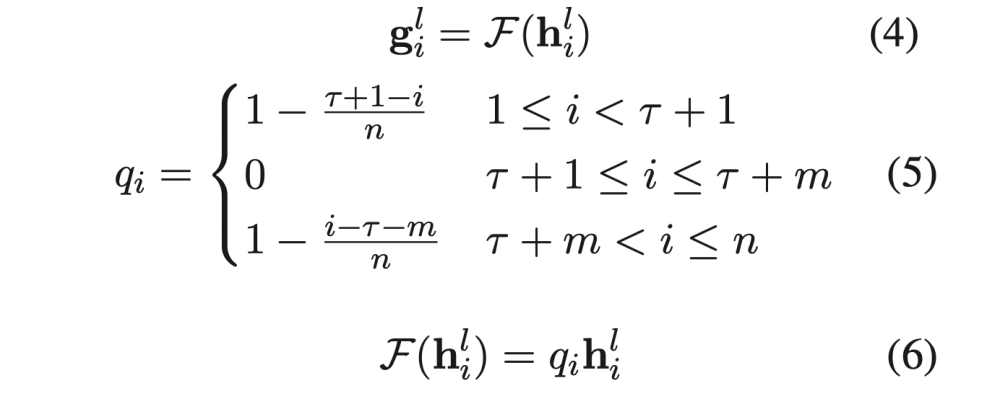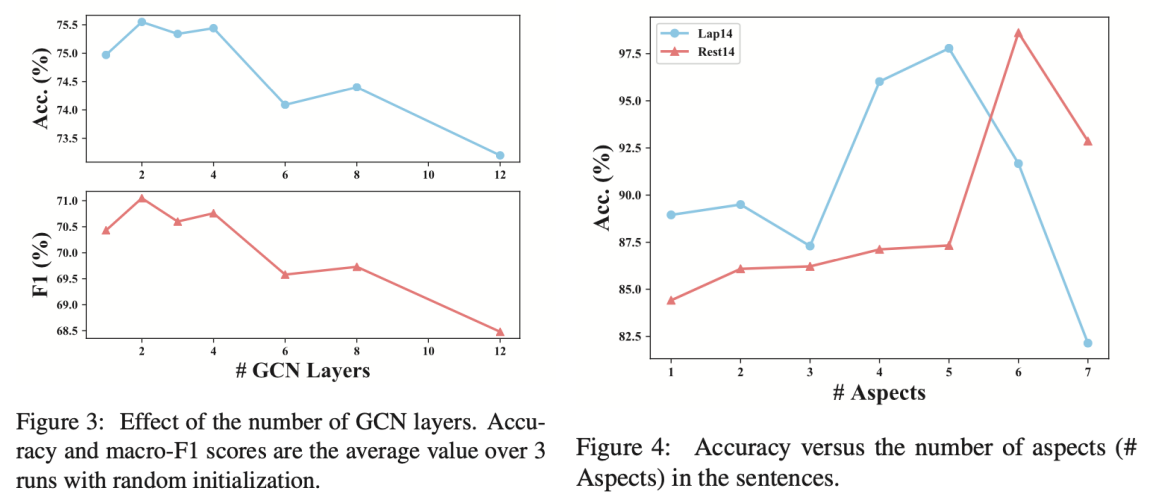Aspect-based Sentiment Classification with Aspect-specific Graph Convolutional Networks (EMNLP 2019)
- 8 mins- Paper Link: https://www.aclweb.org/anthology/D19-1464/
- Author
- Chen Zhang, Qiuchi Li, and Dawei Song
- Beijing Institute of Technology
- Published at
- EMNLP 2019
Abstract
- Aspect-based sentiment classification 태스크에서 attention과 CNN을 많이 씀
- 하지만 이런 모델들은 relevant syntactical constraints와 long-range word dependency를 충분히 고려하지 못하고 있음
- 그래서 aspect sentiment의 판단에 대한 단서로 syntactically irrelevant한 contextual word를 택하는 문제가 생김
- 이런 문제를 해결하기 위해, dependency tree에 대해 Graph Convolutional Network (GCN)을 사용함. 이를 통해 syntactical information과 word dependency를 잘 사용하고자 함
- 구체적으로는 aspect-specific GCN이라는 모델을 제안함
- 3가지 벤치마크 데이터를 이용해 SOTA라는 것을 보였고, syntactical information과 long-range word dependency에 대한 문제가 잘 해결되었다는 것을 graph convolution structure를 통해 보임
1. Introduction
- Aspect-based (aka aspect-level) sentiment classification은 주어진 문장에서 나타난 aspect 단어의 sentiment polarity를 예측하는 문제임
- 예를 들어, “From the speed to the multi-touch gestures this operating system beats Windows easily.” 라는 문장이 있었을 때, aspect로 지정된 “operating system” 은 positive , “Windows” 는 negative 의 polarity를 갖음. 이걸 맞추는 문제임
- Limitation 1 of previous work
- Attention 기반의 RNN 모델들이 최근 좋은 성능을 보이고 있지만, 이들은 문장 내의 context word와 aspect 간의 syntactical dependency를 효과적으로 캡쳐링하기 어려움
- 즉, 현재의 attention mechanism 기반 모델들은 주어진 aspect가 문장에서 관련 없는 context word에 잘못 attending하게 할 수 있다는 것임
- 예를 들어, “Its size is ideal and the weight is acceptable” 이라는 문장에서 attention-based model은 종종 aspect인 size 의 descripor를 acceptable 이라고 보는 경우가 있음 (원래는 ideal 이 맞음)
- 이런 문제를 해결하기 위해, He et al. (2018) 은 attention weight에 syntactical costraint를 주려고 했으나, syntactical structure를 완전히 활용하지 못함
- Limitation 2 of previous work
- Attention 기반의 CNN 모델들은 aspect의 multi-word phrases을 위해 도입됨
- finding of Fan et al. (2018): sentiment of aspect는 보통 individual words가 아니고 key phrases에 의해 결정된다고 주장함
- 하지만 sentiment는 꼭 붙어있는 여러 단어에 의해 depict 되는 것이 아님. 따라서 인접한 연속된 word sequence를 multi-word feature로 쓰는 CNN은 위의 finding을 모델링하기 위한 방법으로 적절하지 않음
- 예를 들어, “The staff should be a bit more friendly.” 라는 문장이 있다고 했을 때, staff 라는 aspect에 대해서 CNN은 more friendly 를 key phrase로 보고 긍정적이라고 예측을 하는데 이는 올바르지 못함. 앞에 should be 가 있기 때문에 반대의 의미로 작용하고 따라서 부정으로 보는 게 맞음
- Attention 기반의 CNN 모델들은 aspect의 multi-word phrases을 위해 도입됨
- 우리는 위의 두 limitation을 해결하기 위해, dependency tree를 기반으로 한 GCN을 도입함. GCN은 syntactically relevant word를 잘 모델링할 수 있고 long-range multi-word relation과 syntactical infromation을 잘 활용할 수 있음. 또한 아직 이 분야에서 GCN은 제대로 사용된 적이 없음
- 우리의 contribution은 다음과 같음
- Aspect-based sentiment classification을 위해 syntactiacal dependency structure를 활용하는 방법을 제안하고 long-range multi-word dependency issue를 해결함
- 이를 위해 Aspect-specific GCN (ASGCN)이라는 novel architecture를 제안함. 우리가 알기론 이 분야에서 GCN은 우리가 처음 한 거임
- Syntactical information과 long-range word dependency를 leveraging하는 것의 중요성과 우리 모델이 이런 부분에 강점을 보인다는 것을 실험을 통해 보여줌
2. Background: Graph Convolutional Network

- GCNs은 local information만 보는 기존 CNNs의 확장판이라고 볼 수 있음. 단순히 인접한 word에 대한 convolution이 아니라, structural informaiton을 기반으로 한 convoluiton이라고 할 수 있음
- Graph convolution을 위해서는 우선 k 개(단어의 개수에 해당함)의 node에 대한 인접행렬 A (k x k) 이 필요함
- Graph convolution은 node representation을 다음과 같이 만듬:

- W^l 은 linear transformation weight이고 b^l 은 bias term임. sigma는 non-linear function (ReLU)
- 간단히 기존 convolution layer를 A 를 기반으로 하는 것임. 기존 convolution은 A 의 연결 관계가 문장 상에서 인접한 단어에만 연결이 되었다고 보는 것임
- GCNs은 보통 위와 같은 graph convolutional layer를 쌓아서(stacking) 만듬. 이렇게 layer를 쌓으면 구조적으로 인접한 node에 서로 영향을 주면서 구조적 정보가 모델링되는 것임
- 문장에서 이런 구조적인 정보를 활용하기 위해 보통 dependency tree를 사용함
3. Aspect-specific Graph Convolutional Network

3.1 Embedding and Bidirectional LSTM
- Input 문장에 대해 word embedding 처리
- 그 다음 Bi-LSTM 태우고, output을 concat해서 최종 hidden representation을 만듬
3.2 Obtaining Aspect-oriented Features
- 일반적인 sentiment classification과 달리, ABSA는 타겟 aspect의 관점에서 sentiment classification을 해야 하고, 따라서 aspect-oriented feature extraction strategy가 필요함
- 이 연구에서 우리는 aspect-oriented feature를 얻기 위해 1) multi-layer graph convolution over the syntactical dependency tree를 적용하고, 2) aspect-specific masking layer를 맨 위에 붙였음
3.2.1 Graph Convolution over Dependency Trees
- 일단 graph convolution에 앞서, 주어진 문장에 대한 dependency tree를 만들어서 인접행렬 A 를 얻어야 함
- 우리는 이렇게 얻은 dependency tree를 기반으로한 ASGCN의 두가지 varient를 제안함
- ASGCN-DG
- Dependency tree를 un-directional graph로 바꿔서 사용하는 방법
- 보통 GCNs이 이렇게 graph를 만들어서 사용하곤 함
- ASGCN-DT
- 방향성을 그대로 유지해서 사용함
- Parent node가 children node의 영향을 폭넓게 받음
- ASGCN-DG
- 또한 Kipf and Welling (2017)이 제안한 self-looping을 적용함. self-looping이란 모든 node에 대해 self edge를 추가하여 loop를 만드는 방법으로, 인접행렬 A 의 대각 성분을 모두 1로 처리하는 기법임
- 이렇게 얻은 최종 A 를 기반으로 아래와 같이 graph convolution operation과 normalization을 통해 각 node의 representation을 update 해나감

- Equation 2는 graph convoution 연산이고, Equation 3은 graph 상의 각 node의 degree를 기반으로 나눠주며 normalization을 하는 것임
- g^(l-1)_j 는 직전 GCN layer를 타고 나왔을 때의 j 번째 단어의 representation이고 h^l_j 는 현재 GCN layer가 만드는 것임
- d_i = sum^n_{j=1} (A_ij) 는 i 번째 토큰의 degree임
- W 와 b 는 trainable parameter
Position-aware Transformation (이해 잘 안됨)

- 앞에서 얻은 graph convolution 연산의 결과인 h 에 대해 position-aware transformation을 함. Equation 4에서 함수 F가 이를 의미함
- F는 aspect 위치에 대한 각 단어의 상대 위치 정보를 기반으로 transformation하는 function인데, aspect에서 멀어질수록 영향력이 감소하도록 되어있음 (Equation 5)
- 이때 aspect 자체는 0을 곱하므로서 aspect 자체는 representation에 관여하지 못하고 contextual words에 대해서만 dependency structure를 기반으로 aspect representation을 형성하도록 함
3.2.2 Aspect-specific Masking
- GCN을 통해 얻게 된 h^L에 대해서 aspect-specific masking 처리를 함
- 간단히 aspect 단어를 제외한 모든 단어에 zero-masking을 하는 것임
- 이를 통해 H^L_mask 를 얻음
3.3 Aspect-aware Attention

- 앞에서 GCN을 통해 구한 aspect의 representation h^L 와 Bi-LSTM의 output h^c 의 attention을 통해서 최종 representation을 만듬
- h^L 은 앞에서 zero-masking을 했기 때문에 aspect 위치의 단어들만 살아있는 상태임
- 이 aspect 단어들과 문장의 각 단어(h^c_t) 간의 dot-product의 합들에 대해서 attention을 취함
- 그렇게 구한 alpha에 대해서 h^c 를 가중합하여 최종 representation r 을 구함
3.4 Sentiment Classification
- r 에 대해 linear 하나 붙여서 최종 classification
3.5 Training
- standard gradient descent
- Cross-entropy loss와 L2-regularization 사용
4. Experiments
4.1 Datasets and Experimental Settings
- 5개의 dataset을 사용
- TWITTER (Dong et al., 2014)
- SemEval 2014(LAP14, REST14), 2015(REST15), 2016(REST16) dataset
- 이전 연구 (Tang et al., 2016b) 처럼 conflicting polarity 샘플과 aspect가 없는 sentence를 제거하였음
- 각 데이터셋 별 label 분포:

- GloVe, Adam 사용함
- learning rate = 1e-3
- coefficient of L2 = 10^5
- batch size = 32
- # of GCN layer = 2
- 실험 결과(Acc, F1)는 random init하여 3번 돌린 결과의 평균임
4.2 Models for Comparison
- SVM (Kiritchenko et al., 2014)
- LSTM (Tang et al., 2016a)
- MemNet (Tang et al., 2016b)
- AOA (Huang et al, 2018)
- IAN (Ma et al., 2017)
- TNet-LF (Li et al., 2018)
- ASCNN: 자체적으로 ASGCN 모델에서 GCN대신 CNN을 사용하여 만듬
4.3 Results

- 제안하는 ASGCN이 SOTA 혹은 baseline(TNet-LF)에 대해 comparable한 성능을 보임
- ASGCN-DG가 DT보다 TWITTER, LAP14, REST15, REST16에 대해서는 꽤 차이를 벌리며 outperform했음
- ASCNN에 비해서 ASGCN이 REST14를 제외한 모든 dataset에서 좋은 성능을 보였는데, 이를 통해 long-range word dependency를 ASGCN이 더 잘 잡아내고 있다는 것을 알 수 있음
- 우리는 REST14와 TWITTER의 문장들이 not so sensitive to syntactic infromation이며, less grammatical하다고 의심 중. 그래서 우리 모델이 baseline보다 조금 부족한 성능을 얻지 않았을까 싶음
4.4 Ablation Study

- w/o pos: removal of position weights
- w/o mask: rid of aspect-specific masking
- w/o GCN: perserving position weights and aspect-specific masking, but without using GCN layers
4.5 Case Study

- Attention visualization을 통해 baseline 모델들과 비교를 해보았음
- First sample: “great food but the service was dreadful!”
- Aspect가 food, service 로 한 문장에 두 개의 aspect가 나타난 케이스임
- Second sample: “The staff should be a bit more friendly.”
- Aspect는 staff 이고, should 에 의해 문장의 의미가 역전되는 케이스임
- Third sample: “Did not enjoy the new Window 8 and touchscreen function.”
- Aspect는 Window 8 이고, 부정어(negation) not 이 등장하는 케이스임
- ASCNN은 local에 집중하기에 2번째 케이스에서 staff 근처에 있는 should 에 잘 집중하여 정답을 맞추었지만, longer-rage word dependency를 잘 처리하지 못해서 3번째 케이스에서는 정답을 맞추지 못함
- ASGCN은 위의 모든 케이스를 다 잘 맞춤
5. Discussion

5.1 Investigation on the Impact of GCN Layers
- GCN layer의 개수는 2개일 때 가장 좋고 늘어날수록 성능이 떨어짐
5.2 Investigation on the Effect of Multiple Aspects
- 한 문장에 여러 개의 aspect가 나타날 수 있음
- Aspect의 개수에 따라 dataset을 나눠서 학습하고 평가해봄
- 1개부터 7개까지 실험을 해보았고, 8개 이상은 샘플 수가 너무 적어서 안했음
- 한 문장에서 aspect의 수가 3개 이상부터는 성능 변동폭이 커지는 걸 볼 수 있는데, low robustness in capturing multiple-aspect correlation을 보여준다고 할 수 있음
- 이런 부분(multi-aspect dependency)을 future work에서 개선할 필요가 있음
6. Related Work
- 생략
7. Conclusions and Future Work
- 우리는 ABSA를 위한 현재 나온 모델들이 당면한 challenges를 재검토하고 GCN이 이런 부분을 tackling하기 적합하다는 것을 보였음
- GCN을 ABSA 문제에 맞춰서 수정하여 novel network인 ASGCN을 제안함
- 실험을 통해 GCN이 syntactiacl infromation과 long-rage word dependency를 leveraging하면서 전반적인 성능 이득을 가져왔다는 걸 보임
- 아직 이번 연구에서는 dependency tree의 edge 정보를 활용하지 않았음
- 우리는 이런 edge 정보를 활용한 graph neural network를 디자인해볼 계획임
- 또한 domain knowledge를 사용하는 것도 고려하고 있음
- 마지막으로 지금은 multiple aspect여도 하나의 aspect에 대해서만 예측을 하고 이를 여러번 하는 건데, 추후에 aspect들 간의 dependency를 포착하여 동시에 multiple aspect의 sentiment를 예측하는 ASGCN의 확장판을 고려 중임
